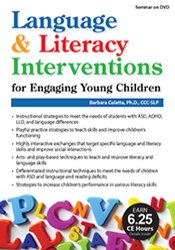

Join language and literacy expert Barbara Culatta, PhD, CCC-SLP, and learn fun and engaging play, arts, and movement-based activities to teach and facilitate children’s language, literacy and social interaction skills. These effective intervention techniques allow children (pre-k through 2nd grade levels) to acquire and use skills to share ideas, feelings and experiences through reading, writing and oral language. You will acquire resources and effective techniques to develop language and literacy skills in children who function at various developmental levels, exhibit different needs, and display characteristics associated with Autism Spectrum Disorder (ASD), Language-Learning Deficits (LLD) and Attention-Deficit / Hyperactivity Disorder (ADHD). You will also learn ways to address the needs of children with language differences, access free materials in English as well as Spanish, and influence the way children interact and communicate in playful language- and literacy-rich contexts. The instructional approach arranges for excellent whole group instruction while also providing intense and differentiated instruction for children who struggle.
You will walk away with the skills necessary to:
This online program is worth 6.25 hours CPD.
| File type | File name | Number of pages | |
|---|---|---|---|
| Manual (11.89 MB) | 109 Pages | Available after Purchase |

Barbara Culatta, Ph.D., CCC-SLP, is an international expert and author on language and literacy interventions. She has been working with children in clinical and educational programs for 45 years. Dr. Culatta is renowned for creating a highly acclaimed language and literacy program (Systematic and Engaging Early Literacy) that utilizes the arts, representational play, and interactive activities as the basis for teaching language and literacy skills; and she has conducted research on the effectiveness of this program with children with ASD. She is well respected for her work in using scripted play, story enactments, and hands-on experiences as contexts for language and literacy instruction and intervention.
Dr. Culatta has written books (Language and Literacy Instruction in the Classroom and Systematic and Engaging Early Literacy), chapters, and publications on language and literacy instruction and interventions. She has received federally-funded professional development and intervention grants to document the effectiveness of innovative instructional approaches. Dr. Culatta’s research revolves around evaluating playful and personally-meaningful language and literacy interventions. She has conducted evidence-based interventions in English and Spanish-speaking settings that included children with challenging behaviors.
Dr. Culatta, professor emerita of Communication Disorders at Brigham Young University, completed her Ph.D. from the University of Pittsburgh and a postdoctoral fellowship from Johns Hopkins University.
Speaker Disclosures:
Financial: Dr. Barbara Culatta is a published author and receives royalties. She receives a speaking honorarium and recording royalties from PESI, Inc. She has no relevant financial relationships with ineligible organizations.
Non-financial: Dr. Barbara Culatta has no relevant non-financial relationships.
Play-, Art- & Movement-Based Practices to Strengthen Language, Literacy and Social-Communication Skills
Child-Centered Interventions for Children with ASD, ADHD, LLD and ELL
Strategies to Increase Phonological Awareness, Decoding and Spelling Skills
Strategies to Facilitate Vocabulary, Oral and Written Language Abilities
Strategies to Promote Social-Communication Skills
Strategies to Address Cognitive and Sensorimotor Underpinnings to Learning
Satisfaction Guarantee
Your satisfaction is our goal and our guarantee. Concerns should be addressed to info@pesi.co.uk or call 01235847393.
Please wait ...